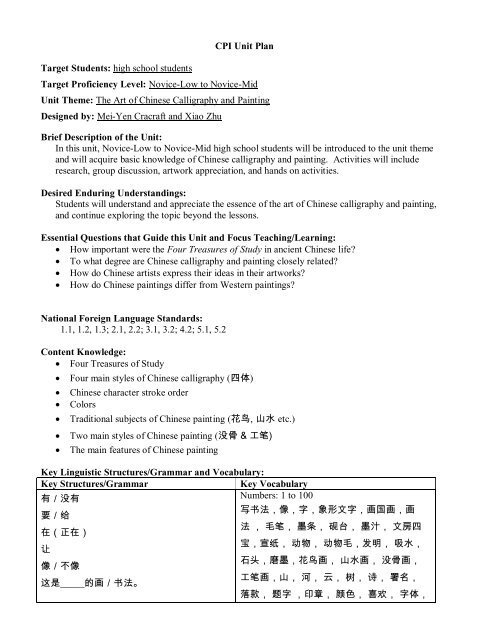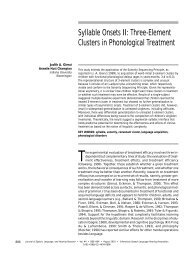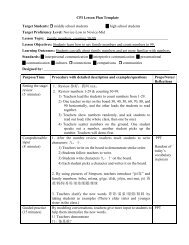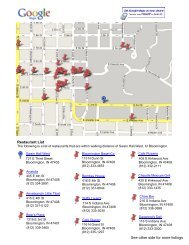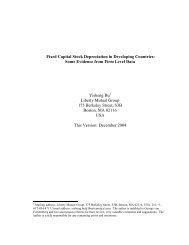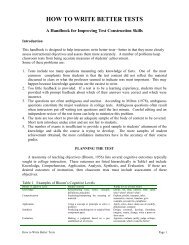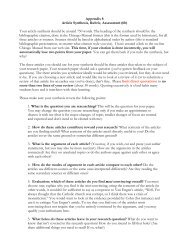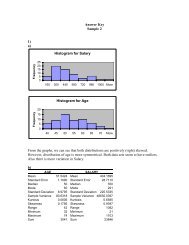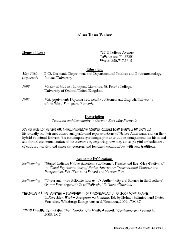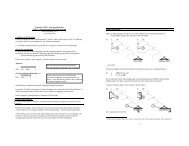CPI Unit Plan Template
CPI Unit Plan Template
CPI Unit Plan Template
You also want an ePaper? Increase the reach of your titles
YUMPU automatically turns print PDFs into web optimized ePapers that Google loves.
Target Students: high school students<br />
<strong>CPI</strong> <strong>Unit</strong> <strong>Plan</strong><br />
Target Proficiency Level: Novice-Low to Novice-Mid<br />
<strong>Unit</strong> Theme: The Art of Chinese Calligraphy and Painting<br />
Designed by: Mei-Yen Cracraft and Xiao Zhu<br />
Brief Description of the <strong>Unit</strong>:<br />
In this unit, Novice-Low to Novice-Mid high school students will be introduced to the unit theme<br />
and will acquire basic knowledge of Chinese calligraphy and painting. Activities will include<br />
research, group discussion, artwork appreciation, and hands on activities.<br />
Desired Enduring Understandings:<br />
Students will understand and appreciate the essence of the art of Chinese calligraphy and painting,<br />
and continue exploring the topic beyond the lessons.<br />
Essential Questions that Guide this <strong>Unit</strong> and Focus Teaching/Learning:<br />
How important were the Four Treasures of Study in ancient Chinese life?<br />
To what degree are Chinese calligraphy and painting closely related?<br />
How do Chinese artists express their ideas in their artworks?<br />
How do Chinese paintings differ from Western paintings?<br />
National Foreign Language Standards:<br />
1.1, 1.2, 1.3; 2.1, 2.2; 3.1, 3.2; 4.2; 5.1, 5.2<br />
Content Knowledge:<br />
Four Treasures of Study<br />
Four main styles of Chinese calligraphy ( 四 体 )<br />
<br />
<br />
<br />
Chinese character stroke order<br />
Colors<br />
Traditional subjects of Chinese painting ( 花 鸟 , 山 水 etc.)<br />
Two main styles of Chinese painting ( 没 骨 & 工 笔 )<br />
<br />
The main features of Chinese painting<br />
Key Linguistic Structures/Grammar and Vocabulary:<br />
Key Structures/Grammar<br />
Key Vocabulary<br />
有 / 没 有<br />
Numbers: 1 to 100<br />
写 书 法 , 像 , 字 , 象 形 文 字 , 画 国 画 , 画<br />
要 / 给<br />
法 , 毛 笔 , 墨 条 , 砚 台 , 墨 汁 , 文 房 四<br />
在 ( 正 在 )<br />
宝 , 宣 纸 , 动 物 , 动 物 毛 , 发 明 , 吸 水 ,<br />
让<br />
石 头 , 磨 墨 , 花 鸟 画 , 山 水 画 , 没 骨 画 ,<br />
像 / 不 像<br />
工 笔 画 , 山 , 河 , 云 , 树 , 诗 , 署 名 ,<br />
这 是 _____ 的 画 / 书 法 。<br />
落 款 , 题 字 , 印 章 , 颜 色 , 喜 欢 , 字 体 ,
我 喜 欢 ____。<br />
我 喜 欢 画 ____。<br />
The word order for 年 月 日<br />
____ 是 ____ 的 (for identifying color)<br />
___ 很 ____ ( 有 意 思 , 好 看 ) 怎 么 样 ___ 还<br />
是 ____A 跟 B 比 A 比 B___ 得 ____ (for<br />
describing how well someone paint or write)<br />
真 、 草 、 隶 、 篆 , 笔 顺 , 意 境 , 留 白 , 中<br />
西 , 不 同 / 相 同 , 特 点 , 还 是 , 比 , 跟 ,<br />
很 , 怎 么 样 , 就 , 行 , 张 , 幅 , 支 , 首 ,<br />
种 , ( 颜 色 ),<br />
洛 阳 纸 贵 , 东 床 快 婿 , 一 字 千 金 , 青 出 于<br />
蓝 , 胸 有 成 竹 , 画 龙 点 睛 , 画 蛇 添 足<br />
Students’ own Chinese names<br />
Skills:<br />
Name the Four Treasures of Study<br />
Write Chinese characters using the correct stroke order<br />
Distinguish different styles of Chinese calligraphy<br />
Write their own names with a Chinese brush<br />
Identify two main styles of Chinese painting<br />
Talk about personal preferences about Chinese calligraphy styles and painting subjects and<br />
artworks<br />
<br />
Identify the elements (such as 山 , 鸟 , 树 , etc.) of traditional Chinese painting<br />
Connections to Other Disciplines:<br />
Literature: poems, idioms<br />
History: Chinese calligraphy, Chinese painting<br />
Fine art: Chinese painting and calligraphy practice<br />
Technology Integration:<br />
PowerPoint presentations, videos and Internet research on Chinese painting and calligraphy.<br />
Assessments:<br />
Performance tasks<br />
Identify the Four Treasures of Study<br />
<br />
<br />
<br />
<br />
<br />
<br />
Identify the elements (such as 山 , 鸟 , 树 , etc.) of traditional Chinese painting<br />
Simple presentations on:<br />
a. The importance of the Four Treasures of Study (Chinese paint brush and paper inventions)<br />
b. The style of a Chinese painting and its artist<br />
Talk with classmates about different styles of Chinese calligraphy and different styles and<br />
subjects of painting and their personal preferences<br />
Write their own names and meaningful Chinese characters with a Chinese brush and using the<br />
correct stroke order<br />
Chinese character writing homework<br />
Final Chinese artwork creation<br />
Quizzes, Tests, Prompts, Work Samples<br />
Vocabulary quizzes<br />
Reading and listening comprehension<br />
2
Unprompted Evidence (observations, dialogues)<br />
Classroom participation<br />
Performance in hands on activities (be careful not to judge the artistic aspects)<br />
Can Do Statements from Linguafolio<br />
I can<br />
Ask for things from other people<br />
Express what I like or dislike<br />
Name basic colors<br />
Describe a painting in simple terms<br />
Simply express personal opinions of artworks<br />
Required Resources:<br />
Sets of the Four Treasures of Study for demonstration and students’ practice<br />
Sample pictures of Chinese calligraphy and painting artwork (PowerPoint)<br />
Chinese paints and equipment<br />
Video clips of Chinese character animation<br />
Computer with Internet connection and projector<br />
Differentiation of Instruction:<br />
To satisfy students’ different learning styles, new cultural aspects and language items are<br />
presented in various forms such as PowerPoint, written language (pinyin and characters), video<br />
clips, handouts and practice demonstration.<br />
Instructional Strategies:<br />
Scaffolding<br />
Teacher/student interaction through questions and classroom discussions<br />
Pair work and group work<br />
Dialogues and presentations<br />
Hands on practice<br />
Games and competitions<br />
DVD watching and artwork appreciation<br />
Student research and discussions<br />
Prior knowledge that will help students learn the new information:<br />
Common knowledge of general colors<br />
Links to relevant web sites:<br />
http://www.youtube.com/watch?v=emXw0pgrrlY (The art of writing)<br />
http://www.csulb.edu/~txie/azi/page1.htm (stroke order)<br />
http://artist.cangdian.com/ (Chinese painting/ calligraphy artists)<br />
http://vr.theatre.ntu.edu.tw/fineart/painter.htm#painter-tw (artists)<br />
http://www.youtube.com/watch?v=eCq8YQ1-o2g (3D Chinese painting)<br />
http://www.youtube.com/watch?v=RxWCAnaKjds (Chinese character/painting animation)<br />
3
Lessons that support the unit:<br />
Activities for Essential Question 1<br />
How important were the Four Treasures of Study in ancient Chinese life?<br />
<br />
Research on 蔡 伦 造 纸 , 蒙 恬 发 明 毛 笔<br />
Activities for Essential Question 2<br />
To what degree are Chinese calligraphy and painting closely related?<br />
<br />
Activities on these two video clips about Chinese character/painting animation<br />
http://www.youtube.com/watch?v=RxWCAnaKjds (Chinese character/painting animation)<br />
http://www.youtube.com/watch?v=emXw0pgrrlY (The art of writing)<br />
Activities for Essential Question 3<br />
How do Chinese artists express their ideas in their artworks?<br />
Activities<br />
Read the poem 寻 隐 者 不 遇 by 贾 岛 and find artwork that represents it<br />
Look at artwork (a little bird nest right by a big waterfall) and guess the topic ( 宁 静 )<br />
<br />
<br />
<br />
<br />
<br />
Introduction and artwork appreciation of the art of inscription, signature and seal in the<br />
Chinese painting<br />
Artwork appreciation and discussion of famous Chinese (painting and calligraphy) artwork<br />
Hands on practice<br />
Field trip to museums (optional)<br />
Guest speaker of local Chinese painting/calligraphy artist (optional)<br />
Activities for Essential Question 4<br />
How do Chinese paintings different from Western paintings?<br />
<br />
Activities on comparing Western and Chinese paintings.<br />
A Culminating Event:<br />
Combine the calligraphy of students’ own names and simple characters that they think are<br />
meaningful for themselves, and then help students create a Chinese painting that corresponds to the<br />
characters.<br />
4
Day One<br />
Lesson Topics: The Four Treasures of Study, introduction of Chinese calligraphy and painting<br />
Learning Outcomes: students can name the Four Treasures of Study and identify few basic<br />
pictographic characters.<br />
Standards: interpersonal communication, interpretive communication, & cultures<br />
Purpose/Time Procedure with detailed description and examples/questions Props/Notes/<br />
Reflections<br />
Setting the stage<br />
(5 minutes)<br />
1. Introduce the importance of Chinese calligraphy and Chinese<br />
painting in Chinese culture and daily life by showing the<br />
pictures (ppt) of Chinese calligraphy/painting artworks and<br />
Pictures<br />
(PPT)<br />
Comprehensible<br />
input<br />
(5 minutes)<br />
Guided practice<br />
(10 minutes)<br />
their appearance on various forms ( 春 联 , 年 画 , 画 扇 , 衣<br />
服 , 手 绢 、 书 信 etc.)<br />
1. Use handout #1 to introduce the Four Treasures of Study, ask<br />
individual students to read out the five parts of the English<br />
explanations.<br />
2. Teach new vocabulary: 文 房 四 宝 , 张 , 幅 , 支 , 毛 笔 ,<br />
动 物 毛 , 墨 , 墨 汁 , 墨 条 , 纸 , 宣 纸 , 吸 水 , 砚 , 砚<br />
台 , 石 头 , 黑 色<br />
1. Play Game: Find my Four Treasures of Study sets.<br />
Demonstrate and practice the Q&As:<br />
A: 你 有 没 有 ____?<br />
B: 我 有 __/ 我 没 有 ___。<br />
A: 我 要 _ 支 / 张 / 个 _。<br />
B: 给 你 。<br />
A: 谢 谢 。<br />
B: 不 谢 。<br />
Ask one student to read out the game instruction on PPT<br />
slides.<br />
Handout #1,<br />
Vocabulary<br />
list<br />
PPT,<br />
Envelopes<br />
with four<br />
treasures of<br />
study pictures<br />
Comprehensible<br />
input<br />
(5 minutes)<br />
Guided practice<br />
(15 minutes)<br />
Pair up the students to start to play the game while teacher<br />
monitors and helps each group.<br />
Explain how Chinese characters and pictures are closely related by<br />
giving examples of pictographic characters (teach Voc.: 象 形 文<br />
字 , Grammar: 像 / 不 像 ; 这 像 不 像 __?) (using handout #2)<br />
1. Divide students into small groups; give students worksheet #1<br />
and ask each group to look at the characters carefully and<br />
guess the meanings first, and write then down under each<br />
character.<br />
2. Ask students to circle the characters that appear in the video<br />
clip<br />
5<br />
Handout #2<br />
Video clip,<br />
PPT,<br />
Worksheet #1
Application and<br />
Extension (3<br />
minutes)<br />
Assessment and<br />
wrap-up<br />
(5 minutes)<br />
Homework/<br />
Preview (2<br />
minutes)<br />
3. Show the video clip of<br />
http://www.youtube.com/watch?v=emXw0pgrrlY (The art of<br />
writing)<br />
4. Ask each group to discuss and modify the meaning of each<br />
character.<br />
5. Competition: Show worksheet PPT, and point at characters<br />
one by one while each group races to guess the meanings.<br />
Whoever gets the right answer (students must say the<br />
characters in Chinese) first gets the point. d<br />
6. Reward the winners and show the video clip again and explain.<br />
1. Idiom story:<br />
洛 阳 纸 贵<br />
1. Assess students’ understanding of this lesson. (Worksheet<br />
#2—comprehension assessment)<br />
1. Character writing homework sheet.<br />
2. Ask students to research on Chinese inventions of paper and<br />
paint brush( 蔡 伦 造 纸 , 蒙 恬 发 明 毛 笔 ) and be prepared to present<br />
the next class.<br />
Handout #3<br />
Worksheet #2<br />
Homework<br />
sheet<br />
6
Day Two<br />
Lesson Topics: The art of Chinese calligraphy and stroke order<br />
Learning Outcomes: Students can identify more basic pictographic characters, distinguish different<br />
styles of Chinese calligraphy, talk about personal preferences about Chinese calligraphy styles and write<br />
Chinese characters using the correct stroke order.<br />
Standards: interpersonal communication, interpretive communication, presentational communication,<br />
cultures and connections<br />
Purpose/Time Procedure with detailed description and examples/questions Props/Notes/<br />
Reflections<br />
Setting the stage<br />
(5 minutes)<br />
(PPT)<br />
Comprehensible<br />
input & Guided<br />
practice<br />
1. Collect homework and review the Four Treasures of Study<br />
2. Students report their research on Chinese inventions of paper<br />
and paintbrush ( 蔡 伦 造 纸 , 蒙 恬 发 明 毛 笔 ) (ask volunteers to<br />
report on each inventions and than ask the whole class to add<br />
on information that were not covered.)<br />
1. Teach vocabulary: 写 , 书 法<br />
2. 小 对 话 :<br />
Handout #1,<br />
Vocabulary<br />
list<br />
(10 minutes)<br />
A: 你 在 做 什 么 ?<br />
B: 我 在 写 书 法 。<br />
Comprehensible<br />
input & Guided<br />
practice<br />
(10 minutes)<br />
Comprehensible<br />
input & Guided<br />
practice<br />
(7 minutes)<br />
A: 让 我 看 看 。 这 不 像 字 ; 这 像 画 。<br />
B: 这 是 字 ; 是 象 形 文 字 。<br />
A: 哦 , 我 知 道 了 。 这 是 日 , 那 是 月 。<br />
B: 答 对 了 !<br />
3. After group practice, ask students to role play (present) 小<br />
对 话<br />
1.More on pictographic characters (review 象 形 文 字 ,<br />
Grammar: 像 / 不 像 ; 这 像 不 像 __?) (using<br />
worksheets #1 – pictures from Amazing Chinese<br />
Characters)<br />
2. Students in small group using 这 像 不 像 __?<br />
sentences discuss the answers.<br />
3. Teacher discusses the answers with the whole class.<br />
4. Show the video clip (parts) of<br />
http://www.youtube.com/watch?v=RxWCAnaKjds<br />
(Chinese character/painting animation)<br />
1 Introduce the brief history about Chinese calligraphy<br />
(handout #2).<br />
2 (Show ppt) Introduce four main calligraphy styles. (Voc:<br />
7<br />
PPT,<br />
worksheets#1,<br />
Video clip<br />
PPT, Handout<br />
#2<br />
Vocabulary<br />
list,
Guided practice<br />
(7 minutes)<br />
Application and<br />
Extension (10<br />
minutes)<br />
Assessment and<br />
wrap-up<br />
(5 minutes)<br />
Homework/<br />
Preview (2<br />
minutes)<br />
哪 种 , 字 体 , 真 、 草 、 隶 、 篆 , 觉 得 )<br />
3 Students discuss different calligraphy styles and express<br />
personal preferences.<br />
你 喜 欢 哪 种 字 体 ?<br />
你 觉 得 这 两 种 字 体 像 不 像 ?<br />
这 是 __ 还 是 ____? 你 喜 欢 ___ 还 是 ____?<br />
你 觉 得 ___ 很 ____ ( 有 意 思 , 好 看 ) 吗 ?<br />
1. Introduction of stroke orders. (handout #3 永 )<br />
2. Show ppt: http://www.csulb.edu/~txie/azi/page1.htm<br />
(stroke order)<br />
3. Have students practice on worksheets<br />
1. Calligraphy artwork appreciation: show ppt of 苏 轼 ( 寒<br />
食 帖 ), 王 羲 之 & 陈 丁 奇 ’s calligraphy artwork and<br />
discuss.<br />
这 是 _____ 的 书 法 。<br />
我 ( 不 ) 喜 欢 ____。<br />
你 觉 得 ___ 很 ____ ( 有 意 思 , 好 看 ) 吗 ?<br />
你 喜 欢 ___ 还 是 ____?<br />
A 跟 B 比 A/B 比 较 __。<br />
我 觉 得 A 比 B__。<br />
2. Idiom story: 东 床 快 婿 and introduce famous artist: 王 羲<br />
之<br />
Assess students’ understanding of this lesson. (Worksheet #3—<br />
comprehension assessment)<br />
1. Character writing homework sheet.<br />
2. Give students handout#5 (simple Chinese character such<br />
as 美 , 真 , 爱 & 仁 ) ask students to think of a character<br />
in Chinese or English that is meaningful to them or<br />
closely related to their life. Write it down and bring it to<br />
the next class.<br />
Handout #3,<br />
PPT,<br />
Worksheet<br />
(homework<br />
sheet) #2<br />
Handout #4<br />
Worksheet #3<br />
Homework<br />
sheet, handout<br />
#5<br />
8
Day Three<br />
Lesson Topics: Chinese calligraphy practice and the art of inscription, signature and seal<br />
Learning Outcomes: Students can write their own names with a Chinese brush and identify the<br />
inscription and signature of an artwork.<br />
Standards: interpersonal communication, interpretive communication, presentational communication<br />
and cultures<br />
Purpose/Time Procedure with detailed description and examples/questions Props/Notes/<br />
Reflections<br />
Setting the stage<br />
(10 minutes)<br />
Comprehensible<br />
input & Guided<br />
practice<br />
1. Set up seats and tables for calligraphy practice prior to<br />
class.<br />
2. Collect homework and review the four main calligraphy<br />
styles<br />
3. Students present the characters that are meaningful to them<br />
or closely related to their lives.<br />
这 是 我 选 的 字 。<br />
我 喜 欢 ____。<br />
我 觉 得 ___ 很 ____ ( 有 意 思 , 好 看 )。<br />
4. Help students translate or pick the characters in Chinese if<br />
there is anyone using English.<br />
1. Teach vocabulary: 中 文 名 字 , 写 得 , 真 好<br />
2. 小 对 话 :<br />
Vocabulary<br />
list<br />
Handout #1,<br />
Vocabulary<br />
list<br />
(5 minutes)<br />
Comprehensible<br />
input<br />
& Guided<br />
practice<br />
(5 minutes)<br />
Comprehensible<br />
input<br />
(5minutes)<br />
Comprehensible<br />
input<br />
& Guided<br />
B: 你 看 这 是 我 的 中 文 名 字 。<br />
A: 你 的 书 法 写 得 真 好 !<br />
3. Have students practice 小 对 话<br />
1. Show ppt and introduce the art of inscription 题 字 and signature<br />
署 名 / 落 款 (They help artists express their ideas in their artworks)<br />
and the word order for 年 月 日<br />
2. Students look at ppt slides and discuss/identify the inscription<br />
and signature of artworks.<br />
1. Introduce the art of seals 印 章 (the different contact and styles) .<br />
(Seals contain not just the artists’ names, they are one of the tools<br />
to help the artists express their ideas in their artworks; some<br />
owners of the artworks – not artists themselves—also use seals to<br />
express their appreciation and ownership of the artworks)<br />
2. Show some actual seals and 印 泥<br />
3. Show ppt of artist 小 鱼 ( 陈 正 隆 )’s seal artwork and pictures of<br />
seal making process.<br />
1. Review stroke order and show ppt and introducing the<br />
correct Chinese calligraphy writing gestures.<br />
9<br />
PPT,<br />
PPT, actual<br />
seals & 印 泥<br />
PPT, sets of<br />
the Four<br />
Treasures of
practice<br />
(25 minutes)<br />
Application and<br />
Extension (3<br />
minutes)<br />
Homework/<br />
Preview (2<br />
minutes)<br />
2. Hand out the Four Treasures of Study sets to the students<br />
and help them practice the correct way of paintbrush<br />
holding.<br />
3. Demonstrate calligraphy writing.<br />
4. Help students to practice calligraphy writing.<br />
5. Students practice writing their Chinese names and the<br />
characters they picked earlier in the class.<br />
Idiom story:<br />
一 字 千 金 (a single word can sometimes wroth of 千 金 –<br />
encourage students to pick their precious 一 字 on their projects)<br />
1. Character writing homework sheet.<br />
2. Ask students to research and pick a few Chinese paintings<br />
they like and be prepared to present the next class.<br />
Study and<br />
other tools<br />
for students<br />
to practice<br />
with,<br />
Vocabulary<br />
list<br />
Handout #2<br />
Homework<br />
sheet<br />
10
Lesson Topics: The art of Chinese painting<br />
Day Four<br />
Learning Outcomes: Students can identify the main styles and elements (such as 山 , 鸟 , 树 , etc.) of<br />
traditional Chinese paintings and talk about personal preferences about painting subjects and artworks<br />
Standards: interpersonal communication, interpretive communication, presentational communication,<br />
cultures, connections and comparisons<br />
Purpose/Time Procedure with detailed description and examples/questions Props/Notes/<br />
Reflections<br />
Setting the stage<br />
(6 minutes)<br />
1. Collect homework and review basic colors.<br />
2. Students present the Chinese paintings they picked.<br />
这 是 我 选 的 画 。<br />
我 喜 欢 ____。<br />
我 觉 得 ___ 很 ____ ( 有 意 思 , 好 看 , 美 , 真 实 …)。<br />
Vocabulary<br />
list<br />
Comprehensible<br />
input & Guided<br />
practice<br />
(7 minutes)<br />
Comprehensible<br />
input<br />
& Guided<br />
practice<br />
(15 minutes)<br />
1. Teach vocabulary: 写 字 , 画 画 , 怎 么 样 , 可 惜 , 颜 色 , 记<br />
得 , 署 名 , 就 , 行<br />
2. 小 对 话 :<br />
A: 你 写 字 , 我 画 画 。 你 看 我 画 得 怎 么 样 ?<br />
B: 有 山 有 水 真 好 看 !<br />
A: 可 惜 没 有 颜 色 。<br />
B: 没 关 系 , 记 得 署 名 就 行 了 !<br />
3. After group practice, ask students to role play (present)<br />
1. Introduce a brief history of Chinese painting (ppt including<br />
文 人 画 ).<br />
2. Introduce Chinese painting colors (show the actual paints)<br />
(compare the colors to Western paint colors)<br />
3. Introduce traditional Chinese painting subjects ( 花 鸟 , 山<br />
水 , 人 物 , 虫 鱼 动 物 etc.) /elements ( 山 , 河 , 云 , 花 ,<br />
鸟 , 人 , 建 筑 物 etc.)<br />
4. Show (ppt) artwork examples and ask students to identify<br />
the subjects and elements: ( 我 猜 / 想 ) 这 是 __。<br />
Handout #1,<br />
Vocabulary<br />
list<br />
PPT, Chinese<br />
paints,<br />
Vocabulary<br />
list<br />
Comprehensible<br />
input<br />
5. Introduce traditional Chinese painting styles 画 法 : 没 骨<br />
画 , 工 笔 画<br />
6. Show (ppt) artwork examples and ask students to identify<br />
the painting styles (including 牧 马 图 v.s. 俊 马 图 ): ( 我 猜<br />
/ 想 ) 这 是 __。<br />
1. Discuss the essentials ( 气 , 意 境 & 留 白 ) and PPT,<br />
11
& Guided<br />
practice<br />
(7 minutes)<br />
Assessment and<br />
wrap-up<br />
(10 minutes)<br />
Application and<br />
Extension (3<br />
minutes)<br />
Homework/<br />
Preview (2<br />
minutes)<br />
characteristics of Chinese paintings<br />
(Essentials ( 气 , 意 境 & 留 白 ): A Chinese painting should have<br />
―qi‖ ( 气 ), a kind of artistic conception. This is not easily<br />
translated, but essentially means that the painting should have life<br />
and energy which is influenced by the artist’s mood and spirit so<br />
that his/her own energy is expressed in the interpretation of the<br />
subject.<br />
Also in Chinese paintings there is an emphasis on leaving space<br />
for imagination which called 留 白 --a kind of artistic conception<br />
that is different from Western paintings.<br />
Characteristics: Chinese painting aims to capture the essence of<br />
a subject, its growth patterns and movements rather than create an<br />
abstract replica. For example, in Western painting, the artist goes<br />
to great lengths to produce a reflection or shadow on a surface.<br />
The Chinese simply describe softness or roughness with wet or<br />
dry brush strokes.<br />
There is much symbolism in the Chinese paintings, and hidden<br />
meanings. )<br />
2. Show ppt artworks and compare/discuss the differences<br />
between Chinese paintings and Western paintings<br />
(Voc: 中 西 , 不 同 / 相 同 , 特 点 )<br />
( 张 大 千 的 荷 花 v.s. Claude Monet's Water-Lilies; 唐 代 的<br />
仕 女 图 v.s. Vermeer's Girl With A Pearl Earring ; 中 国 山 水<br />
画 v.s. 西 洋 风 景 画 )<br />
6. Activity: 由 意 境 找 图 画<br />
Give students worksheet #1 (poem: 寻 隐 者 不 遇 by 贾 岛<br />
松 下 问 童 子 , 言 师 采 药 去 。<br />
只 在 此 山 中 , 云 深 不 知 处 。<br />
with English translation). Discuss the poem and ask students<br />
to see the ppt and pick a painting that represents the poem.<br />
7. Activity: 由 图 画 猜 意 境<br />
Show students the artwork on ppt(a little bird nest right by a<br />
big waterfall) and ask students to guess the topic ( 宁 静 )<br />
Idiom stories:<br />
青 出 于 蓝 , 胸 有 成 竹<br />
3. Character writing homework sheet.<br />
4. Based on the paintings that students pick from last<br />
homework, ask students to research on the painting’s (pick<br />
just one) artist and its style and be prepared to present the<br />
next class.<br />
12<br />
PPT,<br />
worksheet #1<br />
Handout #2<br />
Homework<br />
sheet
Day Five<br />
Lesson Topics: Hands on practice Chinese painting with inscription and signature<br />
Learning Outcomes: Students can create a Chinese painting that corresponds to the simple characters<br />
that they think are meaningful for themselves 题 字 and combine the calligraphy of students’ own names<br />
署 名 .<br />
Standards: presentational communication, cultures, and connections<br />
Purpose/Time Procedure with detailed description and examples/questions Props/Notes/<br />
Reflections<br />
Setting the stage/<br />
review<br />
(10 minutes)<br />
Comprehensible<br />
input<br />
(10 minutes)<br />
Assessment and<br />
wrap-up(25<br />
minutes)<br />
Application and<br />
extension<br />
(3 minutes)<br />
Suggestion on<br />
additional<br />
activities<br />
1. Set up seats and tables for calligraphy practice prior to<br />
class.<br />
Collect homework and review the correct Chinese<br />
calligraphy gestures, 题 字 & 署 名<br />
2. Students present their research on the artist and the<br />
painting style<br />
这 是 __ 的 画 。 这 是 一 幅 __ 画 。 我 觉 得 ___ 的 画 很<br />
____ ( 有 意 思 , 好 看 , 美 , 真 实 …)。<br />
Artwork appreciation on famous artists such as:<br />
吴 道 子 , 范 宽 , 吴 昌 硕 , 齐 白 石 , 张 大 千 & 小 鱼<br />
Combine the calligraphy of students’ own names and simple<br />
characters that they think are meaningful for themselves, and then<br />
help students create a Chinese painting that corresponds to the<br />
characters.<br />
Idiom stories:<br />
画 龙 点 睛 , 画 蛇 添 足 (to show students how important a single<br />
stroke can be in Chinese painting)<br />
1. Field trip to museums<br />
(Give students worksheets with tasks like:<br />
look for an old man with a hat,<br />
<br />
find your favorite painting, look carefully, and<br />
imagine yourself in the painting<br />
2. Guest speaker of local Chinese painting/calligraphy artist<br />
(students can have Q & A with the artist and share their<br />
creation/artworks with each other)<br />
ppt<br />
Sets of the<br />
Four<br />
Treasures of<br />
Study and<br />
painting<br />
tools for<br />
students to<br />
practice with<br />
Handout #1<br />
14


